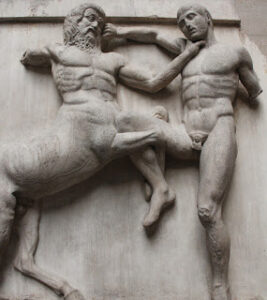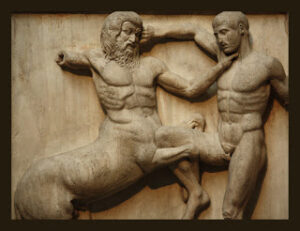After seven years of failed attempts, I finally got my girlfriend to visit the British Museum. One particular piece in the Greek section caught my interest.

Of particular note is the posture of the man fighting the centaur. First of all, note how his leg is hooked around the foreleg of the centaur. You will see this particular leg action in many contexts, one of the most familiar perhaps being in Highland dancing. This is one of those examples of a dance move that is also used as training for a combat move. In combat this swift leg raise can be used to avoid a low strike. The leg action is also used in Highland wrestling and other martial arts as a tripping action. This is what the sculptor has portrayed here, although its effectiveness against a quadruped is doubtful! As well as pulling a leg aside this leg position can be used another way. The toe touches the ground for additional stability and the straightening of the leg used to displace the foe’s leg and shift their balance.
The position of the man’s right hand is also notable. His fist is inverted and he appears to be striking the centaur’s temple. Recently I had watched a Hong Kong movie called “Dragon”. A major plot point was that one character made use of a distinctive strike to the temple. He struck with his fist inverted, using the tip of his thumb, the thumb clamped across the top of his fist.

The technique portrayed by the sculptor is also reminiscent of the punch Jack Dempsey calls the “corkscrew hook”. Readers who had read my book will know that the corkscrew is a technique for coming outside and over an opponent’s guard. This use is consistent with the position of the centaur’s left arm. The man has been grabbed by the throat so counters with a punch to the temple from the outside gate. One of Erle Montaigue’s books has effectively the same technique executed from the “White Crane Spreads Wings” posture. Erle describes it as one of the most powerful punches of any martial art since it is entirely circular in its execution. The fist finishes in an inverted position since this is the most energy efficient and relaxed way to make this punch. No muscular tension is created keeping the palm in an orientation that it does not need to be.
Erle’s example of an application was as follows. An attack with the left hand is deflected to the left with the right hand. The left hand takes over control, taking the defender to the outside gate. The right hand drops down and circles up and in to hit over the arm at the temple. My personal recommendation would be to make this as a palm-strike.